BUICK CENTURY 1996 Owners Manual
Manufacturer: BUICK, Model Year: 1996, Model line: CENTURY, Model: BUICK CENTURY 1996Pages: 340, PDF Size: 17.61 MB
Page 111 of 340
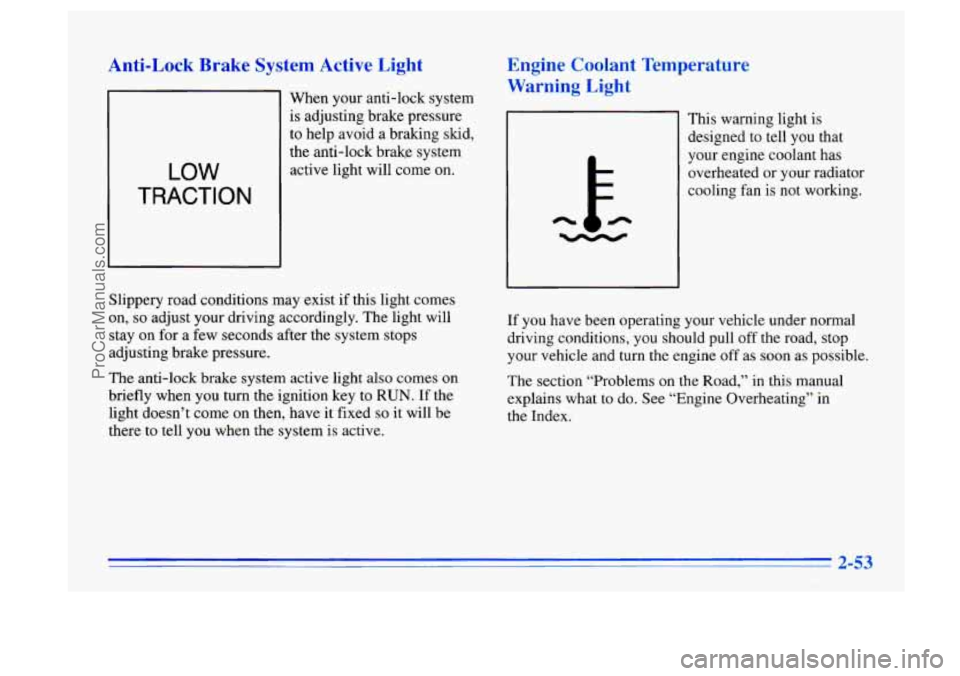
Anti-Lock Brake S A
LOW
TRACTION
When your anti-lock system
is adjusting brake pressure
to help avoid a braking skid,
the anti-lock brakg system active light will come on.
Slippery road conditions may exist if this light comes
on,
so adjust your driving accordingly. The light will
stay
on for a few seconds after the system stops
adjusting brake pressure.
The anti-lock brake system active light also comes on
briefly when
you turn the ignition key to RUN. If the
light doesn’t come
on then, have it fixed so it will be
there to tell you when the system
is active.
Engine Coolant Temperature
Warning
Light
This warning light is
designed to tell you that
your engine coolant has
overheated or your radiator
cooling fan is not working.
If you have been operating your vehicle under normal
driving conditions, you should pull
off the road, stop
your vehicle and turn the engine off as soon as possible.
The section “Problems on the Road,” in this manual
explains what to do. See “Engine Overheating” in
the Index.
2-53
ProCarManuals.com
Page 112 of 340
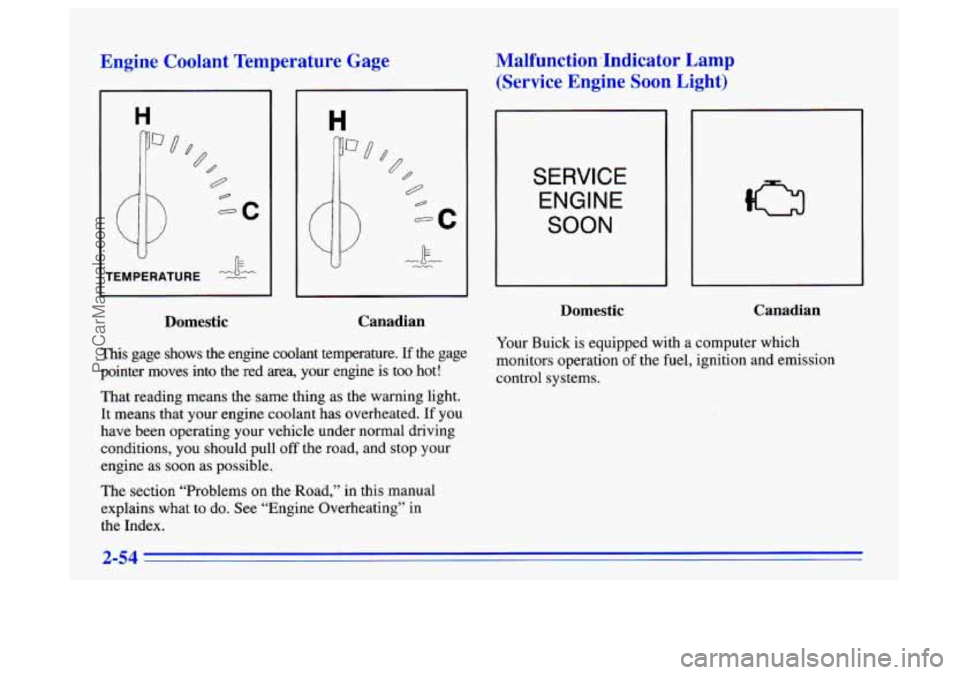
Engine Coolant Temperature Gage
II k
TEMPERATURE -Z
Domestic Canadian
This
gage shows the engine coolant temperature. If the gage
pointer moves into the red area, your engine is too hot!
That reading means the same thing
as the warning light.
It means that your engine coolant has overheated. If you
have been operating your vehicle under normal driving
conditions, you should pull off the road, and stop your
engine as soon as possible.
The section “Problems on the Road,” in this manual
explains what to do. See “Engine Overheating” in
the Index.
Malfunction.Indicator Lamp
(Service Engine Soon Light)
SERVICE
ENGINE
SOON
Domestic Canadian
Your
Buick is equipped with a computer which
monitors operation
of the fuel, ignition and emission
control systems.
2-54
ProCarManuals.com
Page 113 of 340
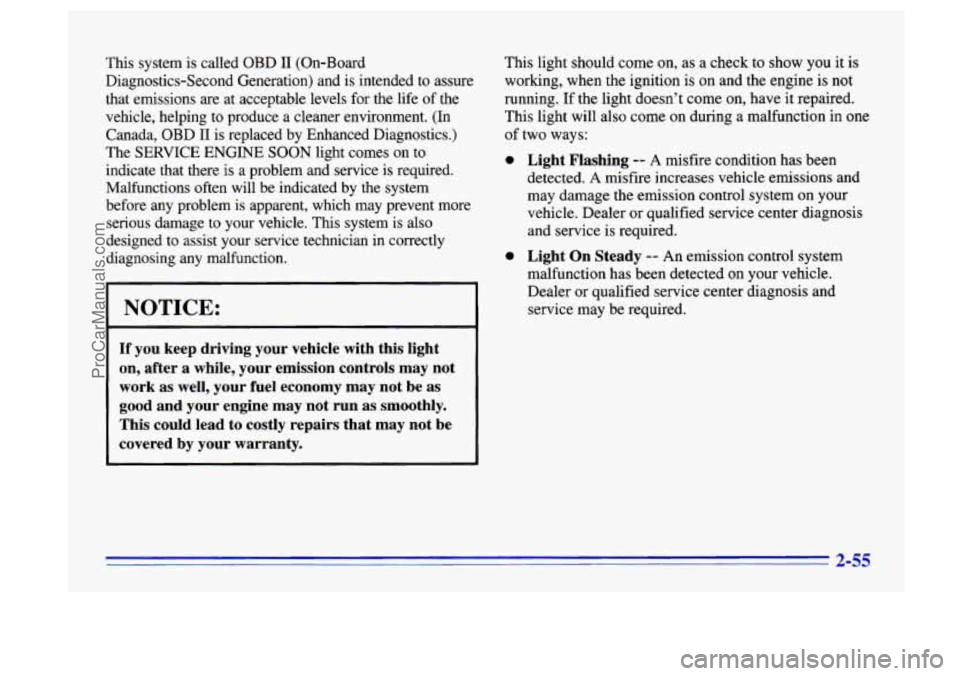
This system is called OBD I1 (On-Board
Diagnostics-Second Generation) and is intended to assure
that emissions are at acceptable levels for the life
of the
vehicle, helping to produce a cleaner environment. (In
Canada, OBD I1 is replaced by Enhanced Diagnostics.)
The SERVICE ENGINE SOON light comes on to
indicate that there is a problem and service is required.
Malfunctions often will be indicated by the system
before any problem
is apparent, which may prevent more
serious damage
to your vehicle. This system is also
designed to assist your service technician in correctly
diagnosing any malfunction.
NOTICE:
If you keep driving your vehicle with this light
on, after a while, your emission controls may not
work as well, your fuel economy may not be as
good and your engine may not run as smoothly.
This could lead to costly repairs that may not be
covered by your warranty.
This light should come on, as a check to show you it is
working, when the ignition is on and the engine is
not
running. If the light doesn’t come on, have it repaired.
This light will also come on during a malfunction in one
of two ways:
0
0 Light Flashing -- A misfire condition has been
detected.
A misfire increases vehicle emissions and
may damage the emission control system on your vehicle. Dealer or qualified service center diagnosis
and service is required.
Light On Steady -- An emission control system
malfunction has been detected on your vehicle.
Dealer or qualified service center diagnosis and service may be required.
2-55
ProCarManuals.com
Page 114 of 340
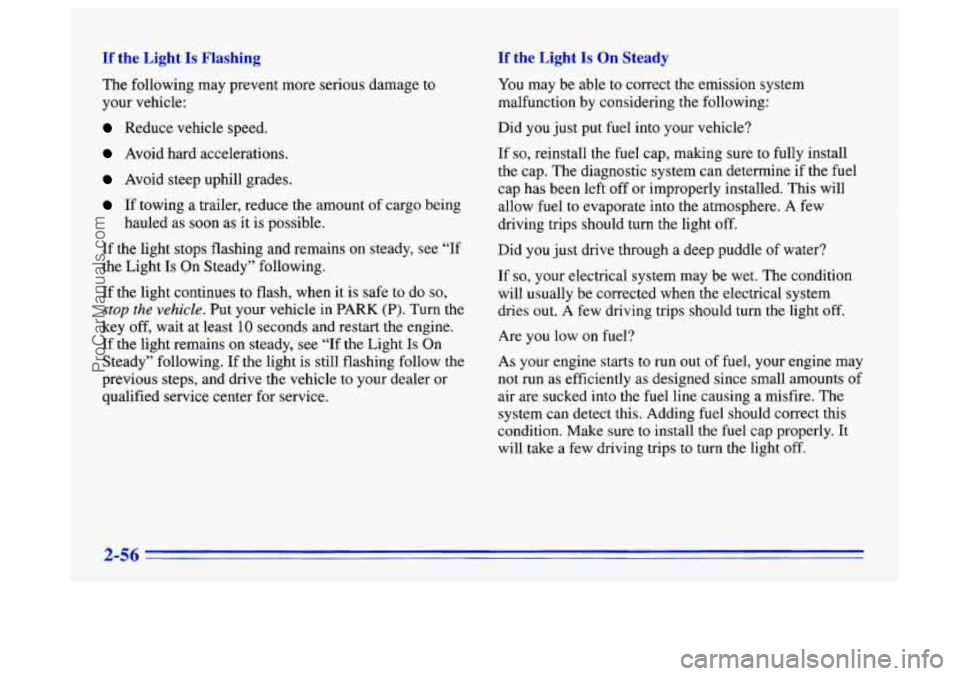
If the Light Is Flashing If the Light Is On Steady
The following may prevent more serious damage to
your vehicle:
Reduce vehicle speed.
Avoid hard accelerations.
Avoid steep uphill grades.
If towing a trailer, reduce the amount of cargo being
hauled as soon
as it is possible.
If the light stops flashing and remains on steady, see
“If
the Light Is On Steady” following.
If the light continues to flash, when it is safe to do
so,
stop the vehicle. Put your vehicle in PARK (P). Turn the
key off, wait at least
10 seconds and restart the engine.
If the light remains on steady, see “If the Light
Is On
Steady” following. If the light
is still flashing follow the
previous steps, and drive the vehicle
to your dealer or
qualified service center for service. You
may be able to correct the emission system
malfunction by considering the following:
Did you just put fuel into your vehicle?
If
so, reinstall the fuel cap, making sure to fully install
the cap. The diagnostic system can determine if the fuel
cap has been left off or improperly installed. This will
allow fuel to evaporate into the atmosphere. A few
driving trips should turn the light off.
Did you just drive through a deep puddle
of water?
If
so, your electrical system may be wet. The condition
will usually be corrected when the electrical system
dries out. A few driving trips should turn the light
off.
Are you low on fuel?
As your engine starts to run out of fuel, your engine may
not run as efficiently
as designed since small amounts of
air are sucked into the
fuel line causing a misfire. The
system can detect this. Adding fuel should correct this
condition. Make sure to install the fuel
cap properly. It
will take a few driving trips to turn the light off.
ProCarManuals.com
Page 115 of 340
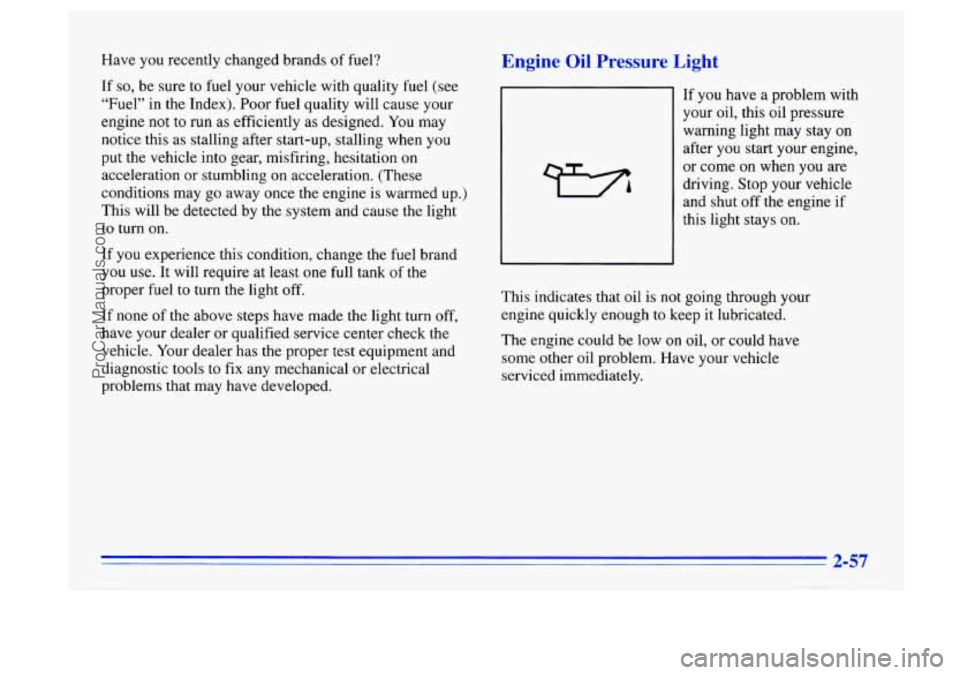
Have you recently changed brands of fuel?
If
so, be sure to fuel your vehicle with quality fuel (see
“Fuel” in the Index). Poor fuel quality will cause your
engine not to run as efficiently as designed. You may
notice this as stalling after start-up, stalling when you
put the vehicle into gear, misfiring, hesitation on
acceleration or stumbling on acceleration. (These
conditions may go away once the engine is warmed up.)
This will be detected by the system and cause
the light
to turn on.
If
you experience this condition, change the fuel brand
you
use. It will require at least one full tank of the
proper fuel
to turn the light off.
If none of the above steps have made the light turn off,
have your dealer or qualified service center check the
vehicle. Your dealer has the proper
test equipment and
diagnostic tools to
fix any mechanical or electrical
problems that may have developed.
Engine Oil Pressure Light
If you have a problem with
your oil, this oil pressure
warning light may stay
on
after you start your engine,
or come
on when you are
driving. Stop your vehicle
and shut
off the engine if
this light stays on.
This indicates that oil is
not going through your
engine quickly enough
to keep it lubricated.
The engine could be low on oil, or could have
some other oil problem. Have your vehicle
serviced immediately.
ProCarManuals.com
Page 116 of 340
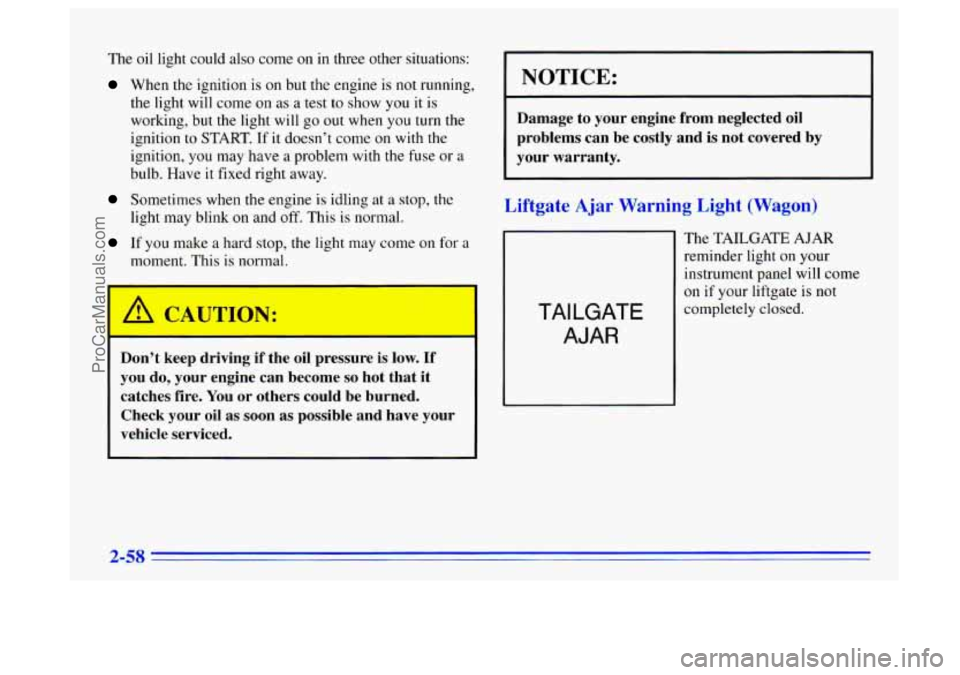
The oil light could also come on in three other situations:
When the ignition is on but the engine is not running,
the light will come
on as a test to show you it is
working, but the light will go out when
you turn the
ignition to START. If it doesn’t come on with the
ignition, you may have
a problem with the fuse or a
bulb. Have
it fixed right away.
Sometimes when the engine is idling at a stop, the
If you make a hard stop, the light may come on for a
light
may blink on and off. This
is normal.
moment. This
is normal.
A CAUTION:
Don’t keep driving if the oil pressure is low. If
you do, your engine can become so hot that it
catches fire.
You or others could be burned.
Check your oil
as soon as possible and have your
vehicle serviced.
I NOTICE:
Damage to your engine from neglected oil
problems can be costly and
is not covered by
your warranty.
Liftgate Ajar Warning Light (Wagon)
The TAILGATE AJAR
reminder light on your instrument panel will come
on if your liftgate is not
TAILGATE
AJAR
2-58
ProCarManuals.com
Page 117 of 340

Fuel Gage
Eg 0
BUNLEADED FUEL ONLY
II
Domestic Canadian
Your fuel gage tells you about how much fuel you have
left, when the ignition is on. When the indicator nears
EMPTY (E), you still have a little fuel left, but you
should get more soon. Here are four
things that some owners ask about. None
of these show a problem with your fuel gage and
are
normal operating characteristics:
At the service station, the gas pump shuts off before
the gage reads FULL (F).
It takes a little more or less fuel to fill up than the
gage indicated. For example, the gage may have
indicated the tank was half full, but it actually took
a
little more or less than half the tank's capacity to fill
the tank.
The gage moves a little when you turn a corner,
0 The gage doesn't go back to EMPTY (E) when you
speed
up or brake.
turn
off the ignition.
I
2-59
ProCarManuals.com
Page 118 of 340
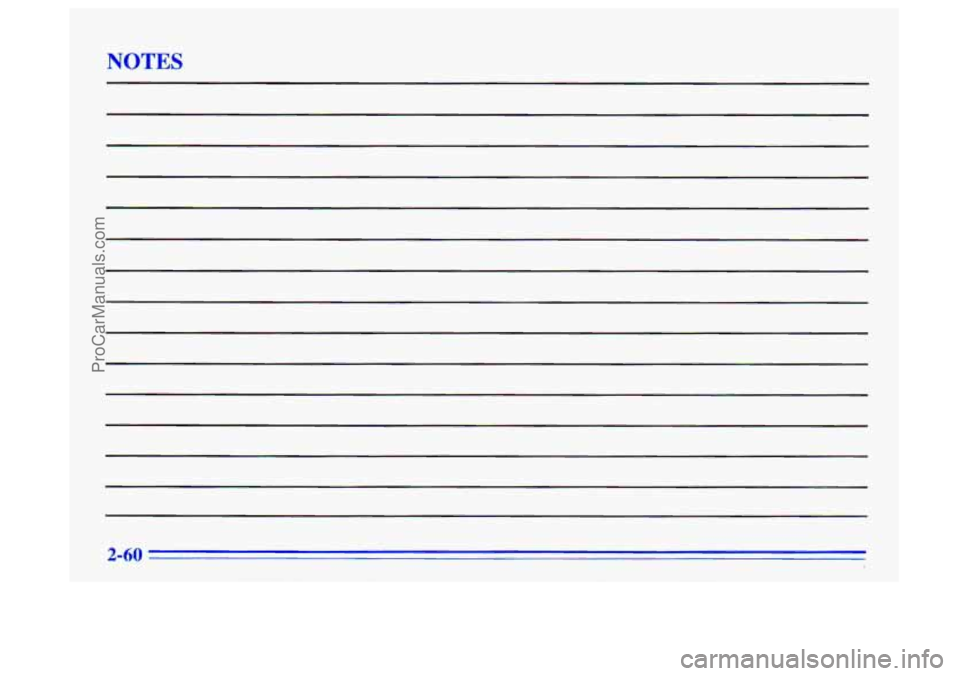
NOTES
2-60
ProCarManuals.com
Page 119 of 340
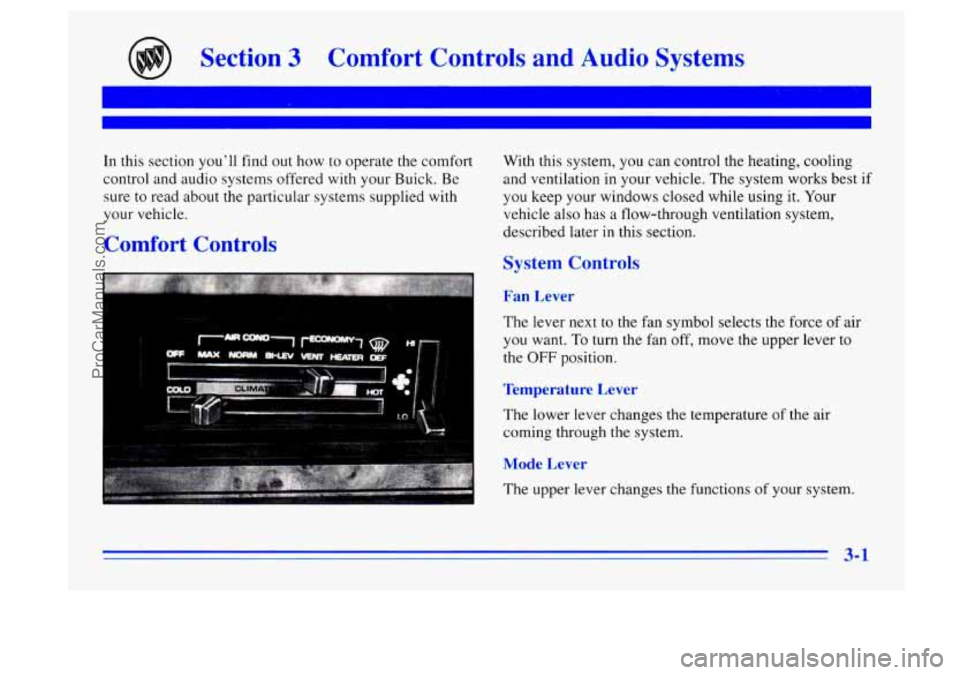
Section 3 Comfort Controls and Audio Systems
In this section you'll find out how to operate the comfort
control and audio systems offered with your Buick. Be
sure to read about the particular systems supplied with
your vehicle.
Comfort Controls
With this system, you can control the heating, cooling
and ventilation in your vehicle. The system works best if
you keep your windows closed while using it. Your
vehicle
also has a flow-through ventilation system,
described later in this section.
System Controls
Fan Lever
The lever next to the fan symb 01 select s the forc 'e of ai
you want. To turn the fan off, move the upper lever to
the
OFF position.
Temperature Lever
The lower lever changes the temperature of the air
coming through the system.
Mode Lever
The upper lever changes the functions of your system.
ProCarManuals.com
Page 120 of 340
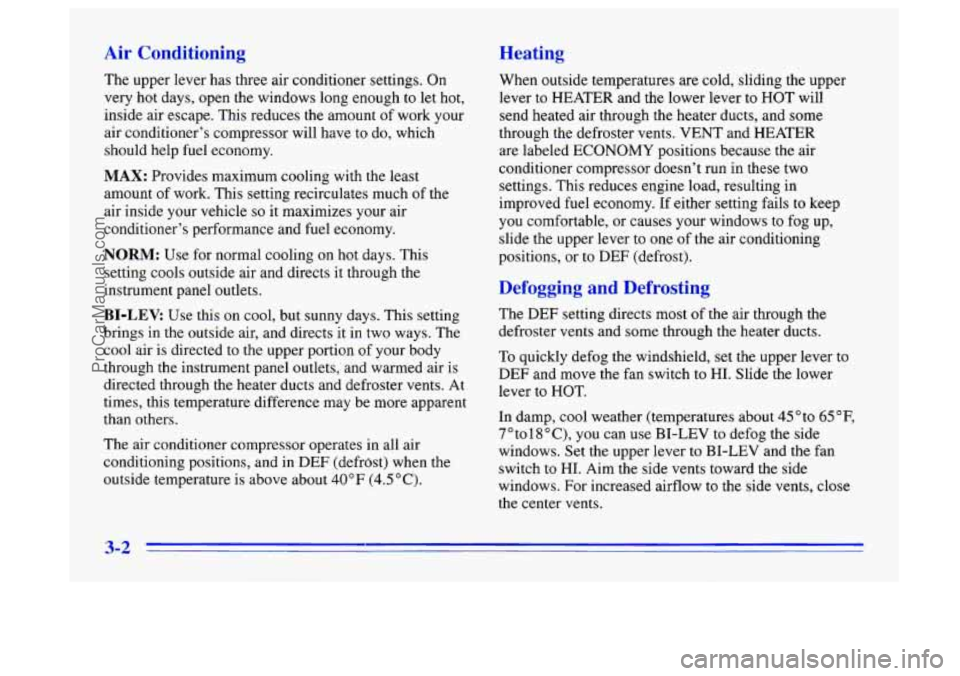
When outside temperatures are cold, sliding the upper
lever to HEATER and the lower lever to HOT will
send heated air through the heater ducts, and some
through the defroster vents. VENT and
HEATER
are labeled ECONOMY positions because the air
conditioner compressor doesn't run
in these two
settings. This reduces engine load, resulting in
improved fuel economy. If either setting fails to keep
you comfortable, or causes your windows to fog up,
slide the upper lever to one
of the air conditioning
positions, or to DEF (defrost).
The
upper lever has three air conditioner settings. On
very hot days, open the windows long enough to let hot,
inside air escape. This reduces the amount
of work your
air conditioner's compressor will have
to do, which
should help fuel economy.
MAX: Provides maximum cooling with the least
amount
of work. This setting recirculates much of the
air inside your vehicle
so it maximizes your air
conditioner's performance and fuel economy.
NORM: Use for normal cooling on hot days. This
setting cools outside air and directs it through the
instrument panel outlets.
BI-LEV: Use this on cool, but sunny days. This setting
brings
in the outside air, and directs it in two ways. The
cool air is directed to the upper portion of your body
through the instrument panel outlets, and warmed air is
directed through the heater ducts and defroster vents. At
times, this temperature difference may be more apparent
than others.
The air conditioner compressor operates in all air
conditioning positions, and in
DEF (defrdst) when the
outside temperature is above about
40°F (4.5"C).
r gii
The DEF setting directs most of the air through the
defroster vents and some through the heater dl
s.
To quickly defog the windshield, set the upper le ~ r to
DEF and move the fan switch to HI. Slide the lower
lever to HOT.
In damp, cool weather (temperatures about 45"to
65"F,
7 " to 18 " C), you can use BI-LEV to defog the side
windows. Set the upper lever to BI-LEV and the fan
switch to HI. Aim the side vents toward the side
windows, For increased airflow to the side vents, close
the center vents.
3-2
ProCarManuals.com